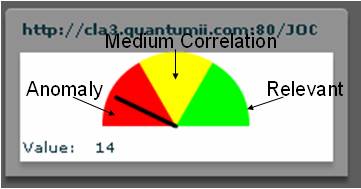 |
|
|||
|
|||||||
Collaborative Learning Agent (CLA) For Trident Warrior 2008 |
||||
DescriptionPort security is
important. The Navy needs to enhance its awareness of potential
threats in this dynamic environment—and plan for potential
high-risk events such as use of maritime shipping for WMD or other
malicious activities. The
CLA technology is used to learn knowledge patterns from historical
Maritime Domain Awareness (MDA) data and then uses the patterns for
prediction and identification of anomalies and reasons that might
cause the anomalies, e.g. weather or potential terrorist activities.
A single CLA learns and
discovers knowledge and behavior patterns from a single historical
data source and the patterns are used for behavior prediction for a
new data. A
set of networked Collaborative Learning Agents (CLAs) forms an agent
network and performs a collaboration to enhance the prediction. We use three
agents in this exercise that can learn patterns from historical maritime
domain information. Agent
1 (http://cla1.quantumii.com/FAIRPLAY)
learns patterns from The Lloyd’s Register – Fairplay (LRF) news; Agent
2 (http://cla2.quantumii.com/JOC)
from the
Journal
of Commerce, which includes information regarding port events,
activities, rules, and policies; and Agent 3 (http://cla3.quantumii.com/MPC) from Maritime
Press Clippings which are freelance vessel and incident reports.
The historical data is up to 6/15/2008. Users need only to
observe the real-time test process, as shown below, as opposed to
the above learning process. In
a real-time test process, when a piece of real-time information is
newly observed, it goes
through the CLA network; the network then returns a report of search
results which shows if the new information is correlated with the
patterns and to what degree the correlation is.
In this exercise, the real-time data from the
SPAWAR MDA DS COI (https://mda.spawar.navy.mil),
including a vessel’s name and position, is collected from each
vessel’s Automatic Identification System (AIS) data.
Each real-time input
goes through the CLA network and is classified into prediction
categories (see Figure 1): 1) Anomaly (red), i.e. a search input that
has low correlation with previously discovered context patterns; 2)
Relevant (green), i.e. an input is highly correlated to the
previously discovered knowledge patterns; 3) Medium Correlation
(yellow), i.e. between relevant and anomaly; 4) Irrelevant (white),
i.e. an input is not related to any of the agents’ knowledge
patterns, or a correlation value can not be computed from the CLA
network.
Figure
1: Anomaly Meter A user will observe the test process for about 100 real-time inputs. Each input (sequence) represents a vessel’s name or real-time location from the SPAWAR MDA DS COI. The input is checked against the patterns in the CLA network to see if anything is of interest or relevance to the vessel or its location; for example, was the vessel seen anywhere else before? Were there any incidents/activities/events reported in the vessel’s location? A user will compare samples of the categorizations (i.e. anomaly, relevant, medium correlation or irrelevant) from the CLA network with his/her own categorization. |
||||
| Site Map | Privacy | Terms |
| Copyright © 2001-2008 Quantum Intelligence Inc. All rights reserved. |
